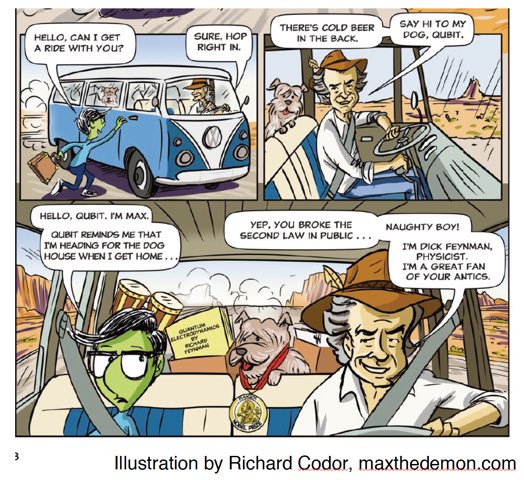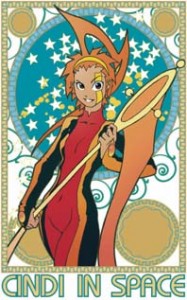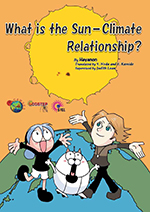I’m going to start with the fun, i.e., “Max the Demon Vs Entropy of Doom”,

Engaging introduction to James Clerk Maxwell’s and his thought experiment concerning entropy, “Maxwell’s demon.”
It’s one of the points that Sarah Klanderman and Josha Ho (both from Marian University; Indiana, US) make in their co-authored August 17, 2023 essay (on The Conversation) about using graphic novels to teach STEM (science, technology, engineering, and mathematics) topics in the classroom, Note: Links have been removed,
Graphic novels – offering visual information married with text – provide a means to engage students without losing all of the rigor of textbooks. As two educators in math and physics, we have found graphic novels to be effective at teaching students of all ability levels. We’ve used graphic novels in our own classes, and we’ve also inspired and encouraged other teachers to use them. And we’re not alone: Other teachers are rejuvenating this analog medium with a high level of success.
In addition to covering a wide range of topics and audiences, graphic novels can explain tough topics without alienating student averse to STEM – science, technology, engineering and math. Even for students who already like math and physics, graphic novels provide a way to dive into topics beyond what is possible in a time-constrained class. In our book “Using Graphic Novels in the STEM Classroom,” we discuss the many reasons why graphic novels have a unique place in math and physics education. …
Klanderman and Ho share some information that was new to me, from the August 17, 2023 essay, Note: Links have been removed,
Increasingly, schools are moving away from textbooks, even though studies show that students learn better using print rather than digital formats [emphasis mine]. Graphic novels offer the best of both worlds: a hybrid between modern and traditional media.
This integration of text with images and diagrams is especially useful in STEM disciplines that require quantitative reading and data analysis skills, like math and physics.
For example, our collaborator Jason Ho, an assistant professor at Dordt University, uses “Max the Demon Vs Entropy of Doom” to teach his physics students about entropy. This topic can be particularly difficult for students because it’s one of the first times when they can’t physically touch something in physics. Instead, students have to rely on math and diagrams to fill in their knowledge.
Rather than stressing over equations, Ho’s students focus on understanding the subject more conceptually. This approach helps build their intuition before diving into the algebra. They get a feeling for the fundamentals before they have to worry about equations.
After having taken Ho’s class, more than 85% of his students agreed that they would recommend using graphic novels in STEM classes, and 90% found this particular use of “Max the Demon” helpful for their learning. When strategically used, graphic novels can create a dynamic, engaging teaching environment even with nuanced, quantitative topics.
…
I encourage you to read the essay in its entirety if you have the time and the interest.
Here’s a link to the publisher’s website, a citation for and description of the book along with a Table of Contents, Note: it seems to be available in the UK only,
Using Graphic Novels in the STEM Classroom by William Boerman-Cornell, Josha Ho, David Klanderman, Sarah Klanderman. Published: 30 Nov 2023 Format: Paperback Edition: 1st Extent: 168 [pp?] ISBN: 9781350279186 Imprint: Bloomsbury Academic Illustrations: 5 bw illus. Dimensions: 234 x 156 mm Publisher: Bloomsbury Publishing Pre-order. Available 30 Nov 2023
Description
This book provides everything STEM teachers need to use graphic novels in order to engage students, explain difficult concepts, and enrich learning. Drawing upon the latest educational research and over 60 years of combined teaching experience, the authors describe the multimodal affordances and constraints of each element of the STEM curriculum. Useful for new and seasoned teachers alike, the chapters provide practical guidance for teaching with graphic novels, with a section each for Science, Technology, Engineering, and Mathematics. An appendix provides nearly 100 short reviews of graphic novels arranged by topic, such as cryptography, evolution, computer coding, skyscraper design, nuclear physics, auto repair, meteorology, and human physiology, allowing the teacher to find multiple graphic novels to enhance almost any unit. These include graphic novel biographies of Stephen Hawking, Jane Goodall, Alan Turing, Rosalind Franklin, as well as popular titles such as T-Minus by Jim Ottaviani, Brooke Gladstone’s The Influencing Machine, Theodoris Andropoulos’s Who Killed Professor X, and Gene [Luen] Yang’s Secret Coders series.
Table of Contents
List of Figures
Foreword, Jay Hosler
Acknowledgements
1. What Research Tells us about Teaching Science, Technology, Engineering, and Mathematics with Graphic Novels
2. Teaching Life Science and Earth Science with Graphic Novels
3. Teaching Physical Science with Graphic Novels
4. Teaching Technology with Graphic Novels
5. Using Graphic Novels to Teach Engineering
6. Teaching Mathematics with Graphic Novels
7. Unanswered Questions and Concluding Thoughts
Appendix: List of STEM Graphic Novels
References
Notes
Index
Finally, h/t August 20, 2023 news item on phys.org

